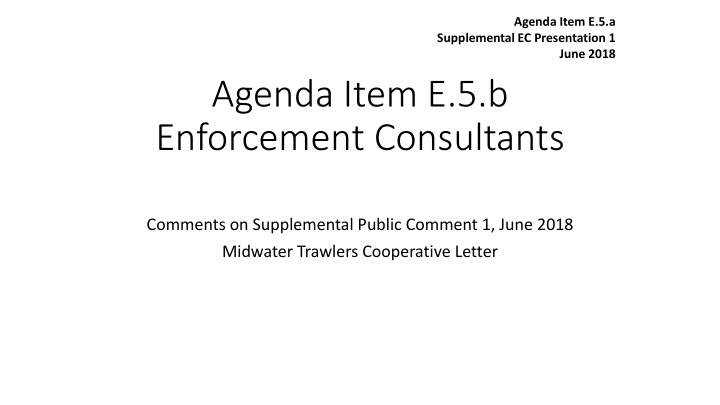



Agenda Item E.5.a Supplemental EC Presentation 1 June 2018 Agenda Item E.5.b Enforcement Consultants Comments on Supplemental Public Comment 1, June 2018 Midwater Trawlers Cooperative Letter
TRat Retention and Disposition Requirement Promulgated Summer of 2010 • 660.140 (g)(3) (g) Retention and disposition requirements— (1) General. Shorebased IFQ Program vessels may discard IFQ species/species groups, provided such discards are accounted for and deducted from QP in the vessel account. With the exception of vessels on Pacific whiting IFQ trips engaged in maximized retention, prohibited and protected species must be discarded at sea; Pacific halibut must be discarded as soon as practicable and the discard mortality must be accounted for and deducted from IBQ pounds in the vessel account. Non-IFQ species and non-groundfish species may be discarded at sea. The sorting of catch, the weighing and discarding of any IBQ and IFQ species, and the retention of IFQ species must be monitored by the observer. (2) Maximized retention for Pacific whiting IFQ trips. Vessels on Pacific whiting IFQ trips may engage in maximized retention. Maximized retention allows for the discard of minor operational amounts of catch at sea if the observer has accounted for the discard. Vessels engaged in maximized retention must retain prohibited species until landing. Protected species may be retained until landing except as provided under paragraph (g)(3) of this section. Pacific
Management Construct and Objectives • Construct • 100% observer coverage required • Consideration of EM was set aside when the fleet transitioned to the catch share program • Objectives • Accountability of catch and discard • Volume estimation, sampling, and species composition of discard
“ Minor or O Oper erational A Amou ounts” ” left und ndefine ned • Why ? • If species composition of the discard and estimation of the volume of the discard is done by the observer, the management objective has been achieved • Defining the size of a lawful vs. unlawful discard is not necessarily germane to achievement of the management objective • Therefore a specific definition was deemed unnecessary
Enforcement Concerns • Enforcement concerns regarding large discard is whether the observer was given the opportunity to sample and estimate the volume of the discard • Corresponding enforcement response is to determine whether the observer was given opportunity to estimate the size and sample the discard, not whether the size of the discard is greater than X • Example: • A sample tow being discarded prior to being brought on board or discarded prior to being transferred to a mothership
Maximum Retention Using EM • 2014 Request to return to EM monitoring using an EFP evaluation approach. • Whiting fleet request was for Maximum Retention. • Fleet Proposal • Because no observer on board all fish would be retained included prohibited species with no sorting required • Terms of the Pacific whiting EM EFP include the following: • “Discard that results when more catch is taken than is necessary to fill the hold is considered to be within the control of the vessel operator and is prohibited."
Fleet Experience • Fleet operated successfully under the terms and conditions in 2015 and 2016 • Significant discards occurred In 2017 • Fleet is now requesting relief from the discard terms and conditions
Alternatives • Per presentations and discussions at the November and March PFMC meetings, Alternative 1 does not allow for an accurate estimation of discards • In discussing Alternative 2 with Jon McVeigh of WCGOP, achievement of the management objectives also appears to be problematic under this alternative
Alternative 3, • Crew sorts prohibited species while the whiting is being discarded • Same activity would occur with an observer on board • Crew retains prohibited fish for Shoreside Catch Monitor to account for, • Assume this done in lieu of the observer doing this on the vessel • Crew Accounts for prohibited fish and discards along with whiting • Assume this means fish are retained and given to the Shoreside Catch Monitor • Noted in log book • Assume discards would be done through a chute with camera observation • Assume the camera review, log book notation, and submittal of catch to the Shoreside Catch Monitor would all correlate • Question becomes, can the camera review species composition of the discard? • Additional discard restrictions, e.g. rockfish must be retained?
Alternative 3 Considerations • In discussions between the EC, GAP, and GMT, the following considerations have emerged: • Are the species composition and volume estimations able to be accurately achieved? • If so, how and at what cost: • Increased review time • More cameras • Implications for other management entities • Catch handling modifications • Further retention requirements • Additional crew training • Ultimately, are the monitoring risks and corresponding uncertainties acceptable to management?
Proposed Electronic Monitoring Rule • 100% observer coverage is required • In lieu of an observer, an exemption for using EM may be granted by the Regional Administrator • Specific criteria regarding camera placement, sensors, catch handling, sorting of catch, discard allowances, etc. are listed in the VMP and are specific to the individual vessel • Modification of EM maximum retention requirements would be addressed through VMP adjustments, not through changes to the EM rule
Enforcement Consultants Conclusions • Alternative 3 is a significant departure from the existing Pacific whiting EFP • Many questions surrounding Alternative 3 are not answered by current EFP • Potential implications for other management entities and processes, such as IPHC and Salmon Biological Opinion • May be appropriate for a new EFP proposal submitted with sufficient detail to allow for comprehensive analysis • Consideration of this approach should not result in delaying finalization of the EM rule
Recommend
More recommend